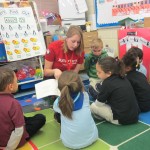“A lot of this is based on district funding, and things like that, which unfortunately tend to be so tied to the proportion of kids and families who are living in poverty,” said Sarah Woulfin, professor of education leadership at The University of Connecticut.
“Student input is critical,” said Sandra Chafouleas, a psychology professor at the University of Connecticut’s Neag School of Education. “We can’t just assume that we know best because we are the adults.”
“To my surprise, the tweet went viral and led to my writing an op-ed in The New York Times entitled ‘I Refuse to Run a Coronavirus Home School.’ Since then, in addition to trying to keep my sanity, I have appeared on shows from ‘Good Morning America’ to ‘Central Time’ on Wisconsin Public Radio, spreading the message to parents that all we can do right now is our best and that’s enough,” says Jennie Weiner, an associate professor of educational leadership. “That we need to have self-compassion because it’s going to be messy, and to remember that educators, too, need our support and compassion as they attempt to be superhuman so we can feel a bit more human.”
“As a parent, it is a daily struggle not to get swept up in the sadness of the losses forced by COVID-1,” writes Sandra Chafouleas, a UConn Board of Trustees Distinguished Professor. “As a school psychologist, I am trying my best to heed what I know about coping and promoting resilience. Life is supposed to present us with bumps — bumps can help us grow if the right supports are available to brace for them. But the intensity of the current global situation means that we need to identify and draw on positive coping resources more purposefully.”
“As we await a potential agreement between MLB ownership and the union to play the 2020 season, there is still a long bridge to cross between policy and reality,” says Doug Glanville, a Neag School faculty member and former MLB player. “In the end, it is a negotiation, and history tells us there must be a compromise if there’s going to be baseball this year. During this coronavirus pandemic, safety has no compromise, of course, but there are elements on the table that leave more room to meet in the middle.”
Cyberbullying could worsen during distance learning unless districts focus on positive online environments for kids, experts say.
The specific factors exacerbating potential threats include more access to technology, less adult supervision, and fewer distractions, said Sandra Chafouleas, a professor at the University of Connecticut’s Neag School of Education.
”We need to get ahead of this crisis to survive and thrive together. It is time to provide alternate options in education preparation so we can continue to prepare high-quality leaders and teachers within this ‘new normal,‘” says Patricia Virella.
“As we piece together what the new normal might look like in our high schools, we should take advantage of this disruption to reconfigure the many moving parts that have been used as excuses for maintaining the status quo,” says Michele Back, an assistant professor of secondary and world languages education in UConn’s Neag School of Education.
“We need to get ahead of this crisis to survive and thrive together. It is time to provide alternate options in education preparation so we can continue to prepare high-quality leaders and teachers within this ‘new normal,'” says Patricia Virella, a Ph.D. student at the Neag School and faculty member at Sarah Lawrence College’s Art of Teaching Program.
Students need to feel safe and have supportive relationships for their social, emotional, and academic learning to be optimized. Students experiencing trauma, such as from public health crises, weather disasters, or other upsetting events, may have been exposed to unpredictable schedules, inconsistent supervision, or food insecurity and desperately need school to be their safest, most predictable, and most positive setting, especially if they have been displaced or are without utilities or basic comforts.


